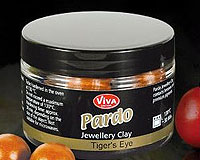f Premo is the workhorse, Pardo is the royalty of all clays. I never made a secret from the fact that Pardo is my most favorite clay of all in existence.
Even if, due to the completely different formula – Pardo is based on bees wax so the whole plasticizer thing is different – it takes a special type of conditioning and care to work with it, it is fully worth the effort.
Pros:
The best polymer clay to use for gemstone imitation techniques. It's not just the Transparent line, but also in the Jewelry line many of the colors have a certain degree of translucency.
The best polymer clay to use for realistic looking faux metal. It doesn't matter if you use the Jewelry line or the Mica Clays line, whichever metallic you use will look beautifully realistic. Most of the times you don't even need to apply enhancers – sand and buff properly and it will look like metal. That comes from the fact that Pardo has the same (if not more) richness of mica particles as Premo, but the mica particles in Pardo are way much smaller, and barely distinguishable with the naked eye.
The best polymer clay to use for making flowers. Cernit might have a reputation for that, but that is just because Pardo hasn't been touted around and there aren't many tutorials out there to show what can be done with it. It has a better translucency than Cernit and, being stiffer, you can work it way better.
Superb hardiness and flexibility. You can make with Pardo such thin pieces that you'd never dream of making with other clays.
Best for cane making due to the texture.
Holds detail the best of all polymer clays I've worked with. I'm talking, 1/10 mm detail.
“Eternal” shelf life. Well I dont' know if really eternal or not, but I've got Pardo that is over 10 years old and can be conditioned with no problem and is just as perfect as the ones from the new packages
Pure color. The palette color in the Art clay line is the “pure color” one. Even in the Jewelry line, the colors are pretty much pure, so you don't get any surprises when mixing colors to get a new hue.
Cons:
Hard to find on the North American market. I mean, really really hard to find. Viva Decor seems to shun the buyers on this side of the ocean
Also it's a tad more pricey than other clays.
The fact that it requires a special type of conditioning. Most people buy Pardo and try to condition it the same as the other clays, are dismayed by the crumbling and just throw it away as being “baked”. It's not. Takes a while to figure out how to work with it.
Talking about working with it, due to the fact that there aren't many tutorials and much information out there, people give up on Pardo.
Cane making – yes, it's great for cane making, but you need to know how to “warm up” an old cane made with Pardo.
It requires special handling when using stamps and molds.
If you don't know how to condition it properly, the translucents will plaque and you'll get a waxy residue on the surface when baking it.
Do I recommend Pardo? It goes without saying. It might take a while to learn how to work with it, but the results are so spectacularly magnificent that it's totally worth it. Give the royalty of polymer clays a try. You will fall in love too.


